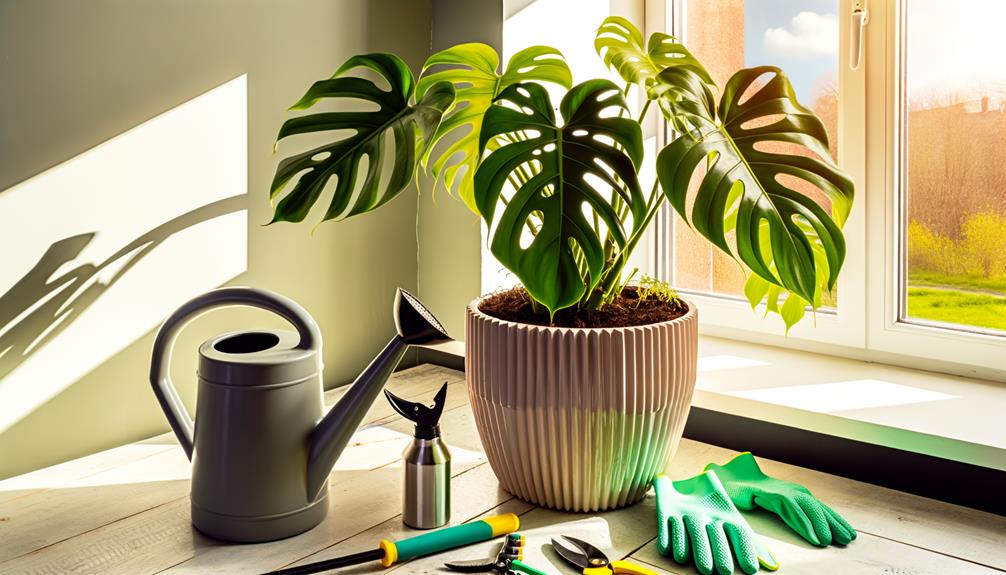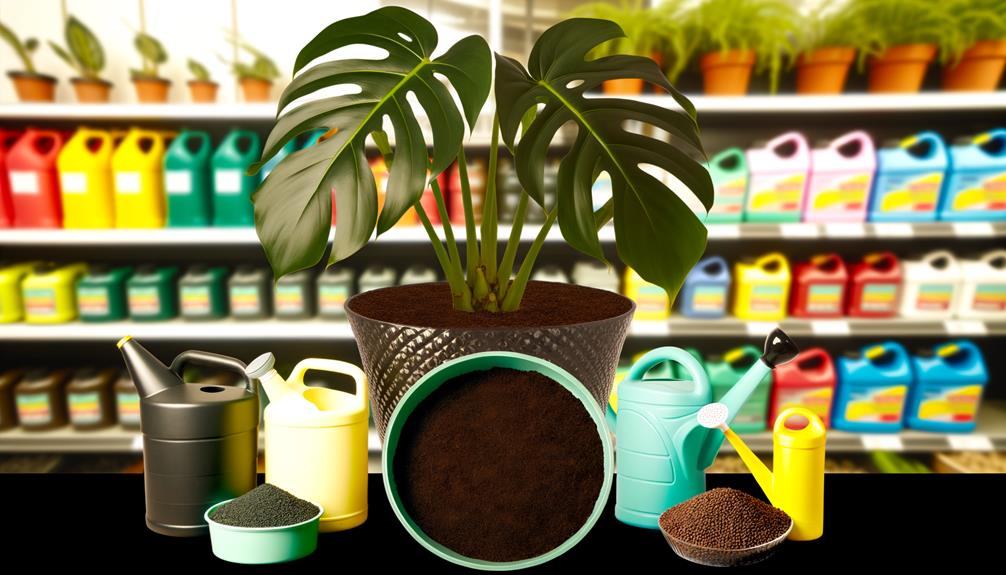How to Care for a Monstera Plant? Complete Guide!
To care for a Monstera plant, place it in bright, indirect light near an east or south-facing window. Water when the top inch of soil is dry, guaranteeing proper drainage with a well-draining mix.
Keep humidity between 60-80% using a humidifier or pebble tray, and fertilize monthly with a balanced 20-20-20 water-soluble fertilizer during the growing season. Rotate the plant occasionally for even growth.
Prune yellowed leaves and leggy stems with clean, sharp tools. Repot every 1-2 years in a pot 1-2 inches larger.
Proper care guarantees vigorous growth and a healthy plant there’s more to explore for in-depth knowledge.

Key Takeaways
- Ensure bright, indirect light and avoid direct sunlight.
- Water when the top inch of soil is dry, approximately every 1-2 weeks.
- Maintain humidity levels between 60-80% using a humidifier or pebble tray.
- Fertilize monthly during the growing season with a balanced, water-soluble fertilizer.
- Prune yellow or damaged leaves and repot in fresh soil every 1-2 years.
Light Requirements

To secure your Monstera thrives, you’ll need to provide it with bright, indirect light, which mimics its natural habitat under the rainforest canopy.
Position your plant near an east or south-facing window, making sure it’s shielded from direct sunlight, which can scorch its leaves. If natural light is insufficient, consider using grow lights with a color temperature of 6500K to simulate daylight.
Rotate the plant occasionally to secure even growth, as Monstera tends to grow toward the light source. Avoid placing it in low-light areas, which can stunt its growth and lead to leggy stems.
By understanding and meeting these light requirements, you secure your Monstera remains healthy and vibrant, developing its characteristic fenestrated leaves.
Watering Schedule
You should water your Monstera plant when the top inch of soil feels dry to the touch, typically every 1-2 weeks.
Overwatering can lead to root rot, so watch for yellowing leaves and a musty soil odor.
Ensuring proper drainage will help maintain the plant’s health and prevent water-related issues.
Ideal Watering Frequency
How often should you water your Monstera to guarantee it thrives in its environment? Typically, you should water your Monstera once every one to two weeks, but this depends on several factors such as humidity, temperature, and light levels.
To guarantee precise watering, adopt these practices:
- Check the soil moisture: Insert your finger about an inch into the soil. If it feels dry, it’s time to water.
- Adjust for seasons: In warmer months, your Monstera may need more frequent watering due to increased evaporation and growth.
- Use proper drainage: Make sure your pot has drainage holes to prevent waterlogging, which can lead to root rot.
Signs of Overwatering
Detecting signs of excessive watering is crucial for maintaining your Monstera’s health and preventing root rot. Look for yellowing leaves, especially the lower ones, as they’re often the first to show distress.
Check the soil; if it’s consistently damp or emits a musty odor, you’re likely overwatering. Wilting can also occur even though the soil is moist. Examine the roots: healthy ones are white and firm, while overwatered roots turn brown and mushy.
Ensure your pot has sufficient drainage holes to allow excess water to drain away. Adjust your watering schedule based on these observations. Typically, wait until the top inch of soil feels dry before watering again.
Monitoring these signs can help you maintain an ideal environment for your Monstera.
Ideal Soil Type

For ideal growth, a Monstera plant thrives in well-draining soil that retains moisture without becoming waterlogged. You’ll want to create a balanced mix to achieve this.
Start with a high-quality potting mix and amend it with additional materials to guarantee proper aeration and drainage.
Here’s a recommended soil blend:
- Coconut coir or peat moss: These materials help retain moisture without becoming soggy.
- Perlite or pumice: These components improve aeration and drainage, preventing root rot.
- Pine bark fines: Adding this helps with long-term soil structure and nutrient retention.
Humidity Needs
Maintaining the right humidity levels is important for a Monstera plant, as it thrives in environments with moderate to high humidity. Aim for humidity levels between 60-80% to achieve optimal growth.
You can achieve this by using a humidifier, placing the plant on a pebble tray filled with water, or misting the leaves regularly. Additionally, grouping plants together can naturally increase humidity levels.
Monitor the humidity using a hygrometer, ensuring it stays within the desired range. Low humidity can cause browning leaf edges and stunted growth, so maintaining adequate moisture is essential.
Avoid placing your Monstera near heating vents or air conditioners, as these can drastically reduce humidity and negatively impact the plant’s health.
Fertilizing Tips

To guarantee your Monstera thrives, use a balanced, water-soluble fertilizer with an N-P-K ratio of 20-20-20. Apply it monthly during the growing season, typically from spring to early fall.
Reduce fertilizing to once every two months during the plant’s dormant winter period.
Optimal Fertilizer Types
Selecting the appropriate fertilizer guarantees that your Monstera plant gets the necessary nutrients it requires for robust growth and lively foliage. Opt for a balanced, water-soluble fertilizer with an N-P-K ratio of 20-20-20 to provide an even supply of essential nutrients.
Slow-release granular fertilizers are also effective, offering a steady nutrient release over time.
When choosing a fertilizer, consider the following:
- Organic vs. Synthetic: Organic fertilizers improve soil health, while synthetic options provide immediate nutrient availability.
- Micronutrients: Ensure the fertilizer contains essential micronutrients like magnesium, iron, and calcium for best plant health.
- Frequency: Select a fertilizer type that aligns with your maintenance routine, ensuring consistent nutrient delivery without over-fertilizing.
Seasonal Fertilizing Schedule
For best growth, fertilize your Monstera plant more frequently during the active growing season, typically from spring through early fall. Use a balanced, water-soluble fertilizer with an N-P-K ratio like 20-20-20 every two weeks. Dilute the fertilizer to half the recommended strength to avoid root burn and nutrient overload.
During the dormant winter months, reduce fertilization to once a month or stop entirely, as the plant’s growth slows down significantly. Always apply fertilizer to moist soil to prevent root damage.
Monitor your Monstera for any signs of nutrient deficiency, such as yellowing leaves, and adjust your fertilization schedule accordingly. This precise regimen ensures your Monstera receives the essential nutrients it needs for peak health and growth.
Pruning Techniques
Properly trimming your Monstera plant not only promotes healthy growth but also helps maintain its aesthetic appeal. Start by using clean, sharp pruning shears to avoid damaging the plant. Focus on removing yellowing or dead leaves, as these can harbor disease. Trim just above a node to encourage new growth.
Here are three key steps:
- Identify the right areas to trim: Look for overgrown stems, damaged leaves, and aerial roots that have become unruly.
- Make clean cuts: Guarantee each cut is smooth to prevent infection.
- Dispose of trimmed material properly: This prevents any potential spread of pests or diseases.
Common Pests

Monstera plants are susceptible to several common pests, including spider mites, mealybugs, and scale insects, which can hinder their growth and health.
Spider mites thrive in dry conditions, forming fine webs on the plant. You’ll notice tiny, moving dots if they’re present.
Mealybugs resemble small, white cotton masses, often hiding in leaf joints. They excrete a sticky substance called honeydew, inviting mold growth.
Scale insects appear as small, brown bumps on stems and leaves, feeding on plant sap and weakening it over time.
To manage these pests, regularly inspect your Monstera, especially the undersides of leaves. Use insecticidal soap or neem oil to treat infestations. Maintain humidity and wipe leaves with a damp cloth to deter pests, ensuring a healthy plant.
Repotting Guide
When it’s time to repot your Monstera, make sure you choose a pot that’s 2-4 inches larger in diameter than the current one to provide ample room for growth. Use a high-quality, well-draining potting mix to prevent root rot.
Follow these steps:
- Remove the Plant: Gently remove the Monstera from its current pot, taking care not to damage the roots.
- Examine the Roots: Trim any dead or rotting roots with sterilized scissors to promote healthy growth.
- Place in New Pot: Position the Monstera in the center of the new pot and fill in with fresh soil, ensuring the plant is stable and upright.
Water thoroughly after repotting and place it in indirect sunlight.
Conclusion
To care for your monstera plant:
- Guarantee it receives bright, indirect light.
- Water it when the top inch of soil is dry.
- Use well-draining soil.
Sustain humidity around 60%, fertilize monthly during the growing season, and trim yellowing leaves.
Watch for pests like spider mites and scale insects, and repot every two years.
By following these steps, you’ll have a thriving, lush monstera that enhances your indoor space with its vibrant, tropical beauty.






